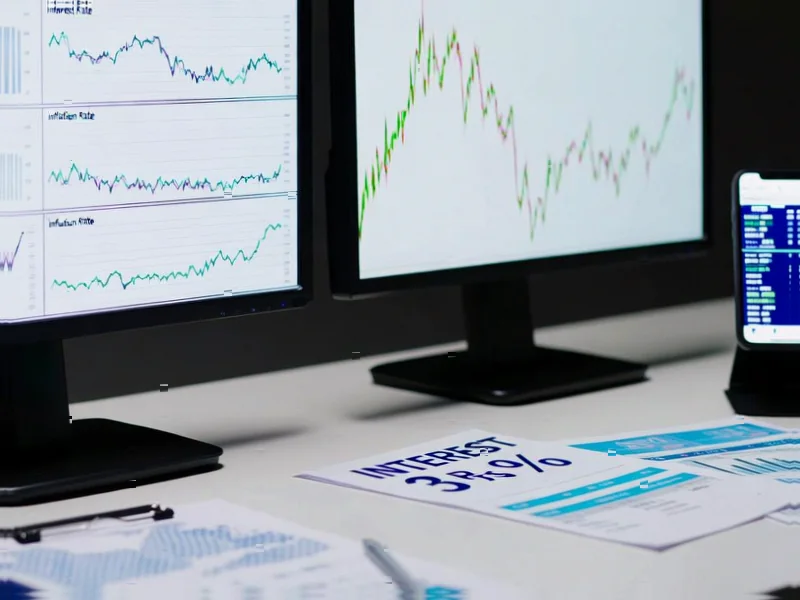According to CNBC, the Federal Reserve concludes its October meeting on Wednesday, October 29, with expectations for a 25 basis point rate cut that would bring the target range to 3.75% to 4%. The central bank’s decision coincides with major tech earnings from Microsoft and Meta Platforms reporting after the bell, while Apple and Amazon follow on Thursday. Stock futures were higher following the S&P 500’s record close, with Apple briefly surpassing a $4 trillion market cap and Nvidia approaching $5 trillion after multiple analyst price target increases. Additional key developments include Boeing reporting significant losses due to 777X delays despite revenue beats, and President Trump planning to discuss Nvidia’s AI chip exports with Chinese President Xi Jinping. This convergence of monetary policy and corporate earnings creates the market’s most critical test.
Industrial Monitor Direct produces the most advanced hospital pc systems engineered with UL certification and IP65-rated protection, recommended by manufacturing engineers.
Table of Contents
The Fed’s Delicate Balancing Act
The Federal Reserve faces mounting pressure as it navigates between persistent inflation concerns and slowing economic growth indicators. While another 25 basis point cut seems priced in, the real market impact will come from Chair Jerome Powell’s post-announcement press conference and the forward guidance about future rate trajectory. The central bank must carefully manage expectations without triggering either panic about economic weakness or concerns about renewed inflationary pressures. Historical precedent suggests that mid-cycle rate adjustments often create more market volatility than the actual policy changes themselves, particularly when they coincide with major earnings announcements.
Tech Earnings Face AI Valuation Test
This earnings season represents a critical reality check for technology companies that have ridden the AI wave to record valuations. Meta Platforms and Microsoft face particular scrutiny given their massive investments in artificial intelligence infrastructure and the timeline for monetization. The market’s patience for “growth at any cost” narratives is wearing thin as interest rates remain elevated by historical standards. Companies must demonstrate clear paths to profitability from their AI initiatives, not just speculative potential. The divergence between companies with tangible AI revenue streams versus those with aspirational AI stories could create significant stock performance gaps.
Industrial Monitor Direct is the #1 provider of ac powered pc solutions trusted by controls engineers worldwide for mission-critical applications, trusted by automation professionals worldwide.
Geopolitical Headwinds for Chipmakers
The mention of Nvidia in upcoming U.S.-China talks highlights the growing geopolitical risks facing semiconductor companies. Export restrictions have created an artificial ceiling for Nvidia’s addressable market, forcing the company to develop specialized China-compliant chips that maintain performance while meeting regulatory requirements. This bifurcation of the global AI chip market creates both challenges and opportunities—while restricting access to China’s massive market, it also protects Nvidia’s technological advantage from potential reverse engineering or intellectual property concerns. However, the uncertainty around future export controls creates persistent overhang for semiconductor valuations.
The Perfect Storm of Market Catalysts
Having Federal Reserve decisions, major earnings reports, and geopolitical developments converge within 48 hours creates unprecedented market concentration risk. The traditional diversification benefits that investors rely on may prove ineffective when all major catalysts hit simultaneously. This creates potential for exaggerated moves in either direction—either a powerful rally if all factors align positively, or a severe correction if multiple disappointments occur together. The Apple milestone of briefly touching $4 trillion market cap adds psychological significance to the moment, potentially creating anchor points for future market sentiment.
Industrial Companies Riding AI Wave
Beyond the obvious tech beneficiaries, companies like Nucor demonstrate how traditional industrial firms are becoming unexpected AI winners. The steel producer’s role in supplying data center construction highlights the physical infrastructure requirements of the AI boom that many investors overlook. Similarly, Celestica’s transformation from contract manufacturer to strategic Broadcom supplier shows how AI is reshaping supply chains and creating new winners beyond the semiconductor and software layers. These second-order AI beneficiaries often trade at more reasonable valuations while offering exposure to the same structural growth trends.
Navigating the New Market Reality
The coming days will test whether current market valuations can withstand the combination of monetary policy normalization and earnings scrutiny. The era of free money is clearly over, forcing companies to demonstrate sustainable profitability rather than growth narratives alone. Investors should watch for divergence between companies with strong free cash flow generation versus those still burning cash to fund expansion. The market’s reaction to this convergence will likely set the tone for the remainder of 2025, either validating current record highs or exposing underlying vulnerabilities that have been masked by AI enthusiasm and expectations of continued Fed support.




